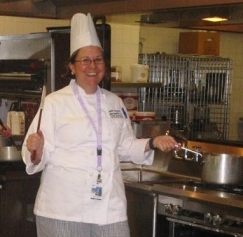Eighteen Students with Sharp Knives
01 June 2009By Allison Shaskan, M.A., CSCE, El Centro College
What do you do when one student takes charge, and the others stand around talking?
I am a chef-educator at El Centro College, a regional two-year community college located in the South. As my culinary program “lives” within a larger college, we admit all students no matter their cooking ability.
This means that on the first day in the kitchen I have 18 students in new uniforms waiting for instruction. Some have worked for years in professional kitchens, some have extensive experience in home kitchens, and some have never turned a stove on to boil water.
Students are put into groups to complete their daily tasks. Each of these daily tasks has been created to cover an essential culinary skill, and our primary aim in the first class that students take (CHEF 1301) is to explain the foundational skills of mise en place. Specifically, we cover classical knife skills, stocks, sauces, vegetables, sandwiches, emulsification and salads in this first course. We have 32 sessions, each of which has food a student must prepare, and for each of these sessions, I have written student-learning outcomes that I hope a student will achieve at 85% proficiency.
While students with years of kitchen experience are adept at mastering our course production, students with no cooking background often struggle with mastering the juggling that chefs must do. For example, pre-preparation, cutting, measuring, gathering equipment, actual cooking, timing and then clean-up occurs for up to six different items on a daily basis, usually in a three-hour period.
What does this mean? It means that the strong students quickly measure all of the ingredients, cut the product, gather the correct equipment, efficiently cook the daily assignment, and then effectively clean their area, as well as perform one of five rotating positions they are assigned for that day. The other group members will often stand around looking intimidated by a peer whose level of functioning is high.
What do you do when one student seems to take charge, and others stand around talking?
How do you integrate the weak student into the high-functioning student’s group? How do you keep the weaker student from hiding, and the stronger student from getting irritated from the perception of overwork?
Self-propelled Dynamics
Here are some concrete steps that have assisted me in the development of my students.
- First, observe students in a natural setting. Don’t cause them anxiety by watching over their shoulder, but watch to see what they are capable of.
- Next, determine who works well together and who doesn’t. While the idea of every student getting along with another is a great idea, the reality is that there are some personalities that just don’t mesh well with others. Determine what kind of personality each student possesses, and pair him or her with another person with whom he or she is compatible. This shouldn’t be an episode of “Wife Swap,” as kitchens have enough drama without knife fights breaking out.
- Try to figure out what type of learning style each student has. You can do this by figuring out who likes pressure, who likes a relaxed work environment, and who needs a mixture of both.
- Then arrange your groups in such a way that students are relaxed. If relaxed, I’ve found productivity increases. Don’t place slower students who need a more encouraging team, with irritable, impatient ones. No one will be happy.
- Encourage the students with weaker skills to practice their skills at home.
- Finally, explain to the faster students that you understand their skill level, and with encouragement the group shortly will function efficiently.
By observing skills, identifying abilities, reorganizing groups and then developing the weaker students, I have found that by the midway point in my semester-long class, the group dynamics are self-propelled.
I am happiest when all students learn, and share the workload effectively. By taking the faster students into your confidence and getting them to buy into the development of their teammates, they feel less burdened, and the team is well on its way toward maximum productivity.
The only difficulty I find? At the end of the semester, when students are actually ready to perform with speed, they leave my class and I have to start the same process all over again with an entirely new group of un-trained students!

Allison Shaskan, M.A., CSCE, is a chef instructor at El Centro College in Dallas. She is currently a doctoral candidate at the University of North Texas. Her research interests include national culinary-arts-curriculum norms and the evolution of the field of gastronomy. Shaskan holds a bachelor’s degree from the University of Arizona and a master’s degree in rhetoric from Northern Illinois University. She attended culinary school at the Cooking and Hospitality Institute of Chicago. As executive director of an apprenticeship program at Pulaski Technical College Arkansas Culinary School, she wrote the Associate in Applied Sciences degree program for culinary arts, which was approved by the Arkansas State Coordinating Board in 2006.
